The sky in the southeast was growing grey when I awoke. A fitful breeze blew over the hill, stirring the branches above my head. I would have preferred to remain in the warmth of my sleeping bag, but I was technically trespassing and I didn't want to outstay my welcome. By the time I had packed there was light enough for walking.
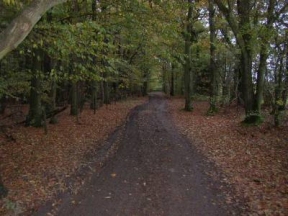
It was a cold morning, but it did not look like rain. I followed the road for a while, looking out over lands still lying in shadow, then entered gloomy Hyden Wood. The trees by the track seemed old and forlorn, tinged with the hues of the dying year. H.M.S. Mercury I passed, sad and neglected behind high fences of barbed wire, then northward over Salt Hill. Away to my left across a broad valley were long dark slopes and the wooded approaches to Old Winchester Hill.

After a mile or so the Way abandoned the ridge, dropping down through bare, featureless fields. On hard concrete tracks I entered the land of the agribarons. Sterile and dreary, stripped of untidy hedgerows and coppices, it smelt uneasily of money. The Meon River rises here, bubbling up in a series of springs that have been dammed to create a trout fishery. Passing the estate offices of Whitewood Farm I began the long ascent to the road. This is cattle country, and the ground was badly cut up. A bull had taken possession of the official path; so I followed the edge of the field, climbing the fence at the top. Then off along the curve of the hill to the fort perched on the outermost spur.
The views from the ramparts were wild and lonely. Miles of country lay ahead, open and featureless for the most part. At my feet the ground fell sharply to the Meon valley, before rising up once more to Beacon Hill. Long slopes reached to the far horizon; wide fields reflected the stormy sky. There was little shelter on that exposed plateau, and for want of anywhere better I stopped for breakfast in the ditch by the western entrance. Not an ideal picnic spot; it was cold and muddy, and I wrapped myself in the poncho to keep out the searching wind. Hot coffee and hot food went some way towards restoring morale – a curious mixture of sausage, beans, mashed potatoes and oatmeal, but it was welcome nonetheless. I was grateful, and not for the first time, that Trangias work so well in any weather.
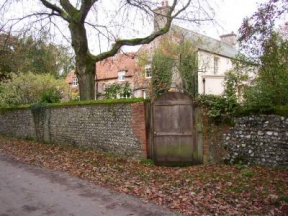
While resting my body temperature had dropped, but I soon warmed up. The path to Exton lay in the lee of the hill, sinking gently to the valley bottom. It was wet in places, but passable with care. The Meon is a typical chalk river: a bright channel in the summer sunshine, turbulent in winter. I crossed the swollen stream on a narrow footbridge and entered Exton.
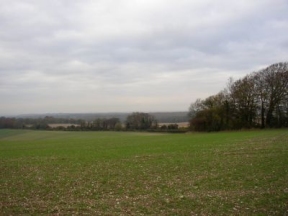
It did not occur to me at the time, but this was the first village I had passed through in the thirty-five miles from Amberley. It is some indication of the rural nature of the South Downs Way, particularly the western arm, that there are so few settlements along the route. Exton is a hamlet really, and there was no one about, but just to be among human dwellings once more was comforting after miles of lonely countryside. The people I met a little later, a group of elderly ramblers out for the day. As I caught up with them someone shouted cheerfully down the line: “Make way for a real walker!” I was flattered, and undeservedly so. Walking is not about achieving distance, but enjoyment. And I’m pretty sure that they got as much pleasure from their walk as I did from mine. I hope so, anyway – they were a friendly bunch, and they certainly brightened up my day!
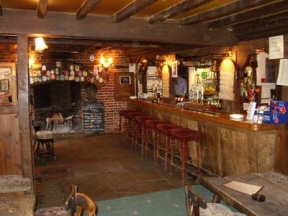
It’s a fair slog up to the shoulder of Beacon Hill, over four hundred feet in all. From there the path keeps to the top of the ridge for several miles until it joins the road leading to the inn known as Milbury’s. Everyone walking the South Downs Way drops in at Milbury’s and everyone should. It is only eight miles from Winchester; too close, perhaps, to stop for the night, though it would be a pleasant place to put up if you were finishing the Way and wanted to celebrate in comfort.
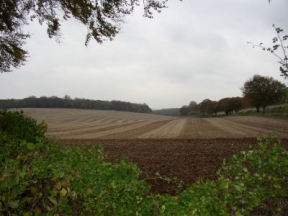
It was still early when I arrived, and I was the only customer. I changed my muddy boots for a pair of sandals and, mindful of disapproving looks from landlords in the past, asked the barman if he would prefer me to leave my rucksack in the porch. Not a bit of it. Bring it in, he said, and put it anywhere! I was surprised, but less so when it came out in conversation that he was a walker himself. This, I felt, might account for a refreshingly casual attitude to a bit of mud. While I was there I had a look at the well in the back bar, which must be one of the deepest in Britain. It takes six seconds for an ice cube dropped through the grille to hit the water.
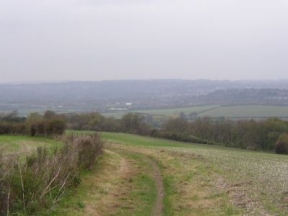
After five long days the walk came to an end peacefully. The last part of the South Downs Way is a pleasant stroll through rolling farmland. I had the whole afternoon to complete it and I ambled on at a steady pace. The landscape here is an understatement. There are no steep slopes now, no high tracks touching the sky. Even the first sight of Winchester is muted. Quietly I passed through a long line of beeches; and as I came over the brow of the hill it lay before me, grey and insubstantial in the falling rain. I could not see the cathedral; it had faded and become one with the city it served.
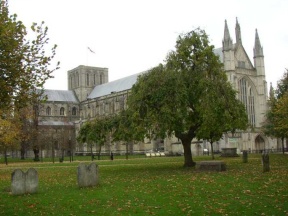
The view declined as I dropped down to Chilcomb. Tired now I rested for a few minutes, then followed the path along the edge of a field. A mile further on I came to the footbridge over the motorway. I crossed the dizzy span, high above the noise and confusion; and there, suddenly, was the city. Long dark streets led to the centre, past shops and houses of red brick. They brought me to the mill race, and I followed the shaded walk for a short way upstream until I came from the silent gloom of the trees out into the busy lamp-lit High Street.
There were just a few more yards to go now. I turned left, past the statue of King Alfred, and left again into the quiet close; and there at last, grey under the sky, I saw the great bulk of the cathedral.

